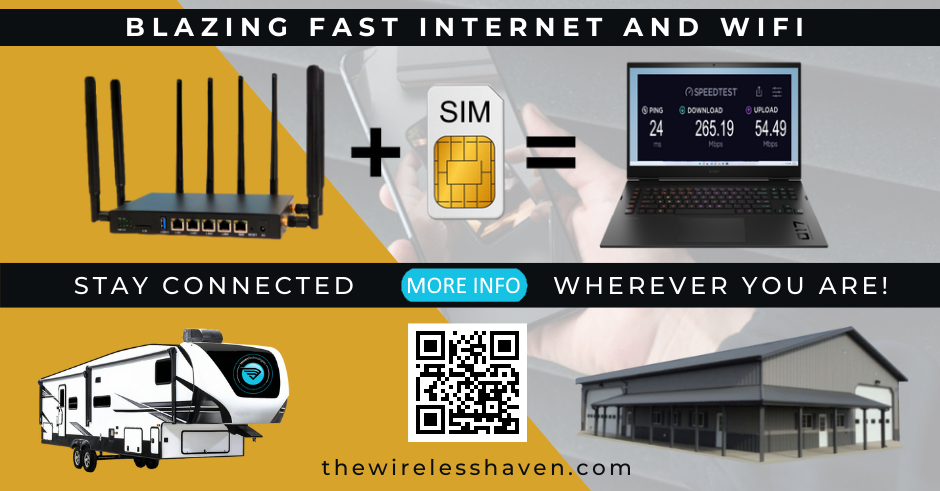I recently configured a WE826-T with GoldenOrb | Rooter to use with T-Mobile.
While I normally configure and program the MC7455 prior to installation, I did not do so on this build. I installed the MC7455 into the WE826, updated the firmware to ROOter, set the root password, the APN for T-Mobile, made a few adjustments on the WiFi and did a hard reboot (using the power cord). When it came back online, it connected to the network almost immediately. However, when I check out the NETWORK > INTERFACES tab for WAN1 (wwan0), it showed only an ipv4 address.
I decided to start with the MC7455 as to the reason it lacked an IPV6 address. Off top of my head, I could only think of a few possibilities:
(1) The SIM Card and service would not allow for an IPV6 address (e.g.,Sprint's ZTE Pocket WiFi),
(2) The APN was programmed only for an IPV4 address, or,
(3) IPV6 is not enabled in the MC7455.
Having previously configured a T-Mobile router, I discounted the first possibility. Prior to installing a MC7455, I generally configure the last two possibilities when I set up the modem. So figured these would be my immediate targets.
I went into the MODEM > MISCELLANEOUS tab to access the AT-COMMAND TERMINAL.
The first item I checked was the composition of the modem:
Code: Select all
at!entercnd="A710"
at!usbcomp?
Code: Select all
at!entercnd="A710"
The "at!usbcomp?" command returned:
Code: Select all
at!usbcomp?
Config Index: 1
Config Type: 1 (Generic)
Interface bitmask: 0000050D (diag,nmea,modem,rmnet0,rmnet1)
OK
Helpful Reminder: Notice the "?" on the end of the "at!usbcomp?" command. You will notice the "?" and "=?" on various AT Commands. The difference is the "?" is requesting specific information about the modem's current configuration, where the "=?" generally requests the options available for the command. For example, and using our command above, if we wanted to know what USB compositions were available:
Code: Select all
at!usbcomp=?
Code: Select all
at!usbcomp =?
!USBCOMP:
AT!USBCOMP=<Config Index>,<Config Type>,<Interface bitmask>
<Config Index> - configuration index to which the composition applies, should be 1
<Config Type> - 1:Generic, 2:USBIF-MBIM, 3:RNDIS
config type 2/3 should only be used for specific Sierra PIDs: 68B1, 9068
customized VID/PID should use config type 1
<Interface bitmask> - DIAG - 0x00000001,
NMEA - 0x00000004,
MODEM - 0x00000008,
RMNET0 - 0x00000100,
RMNET1 - 0x00000400,
MBIM - 0x00001000,
e.g.
10D - diag, nmea, modem, rmnet interfaces enabled
1009 - diag, modem, mbim interfaces enabled
The default configuration is:
at!usbcomp=1,1,10F
OK
Code: Select all
at!entercnd="A710"
at!usbcomp = 1,1,1009
at!reset
The command responded with:
Code: Select all
at!usbcomp = 1,1,1009
OK
Code: Select all
at!selrat=06 (set the modem to receive LTE only)
at+cfun=? (sets the modem to full functionality)
at!band=00 (sets the modem bands to ALL bands)
at!custom="IPV6ENABLE",1 (enables IPV6)
at+cgdcont=1,"ipv4v6","fast.t-mobile.com" (sets a IPV4V6 APN for T-Mobile)
at!reset (reboots the modem)
Code: Select all
at!entercnd="A710"
at!usbcomp = 1,1,1009
at!selrat=06
at+cfun=?
at!band=00
at!custom="IPV6ENABLE",1
at!reset
When the MC7455 comes back on line and connects, assuming no other interfaces have been modified or altered, you should have an IPV4 and IPV6 address.
If any of the interfaces were modified, and prior to performing the above, I would suggest resetting ROOter to its default settings. Go to SYSTEM > BACKUP/FLASH FIRMWARE > PERFORM RESET.


